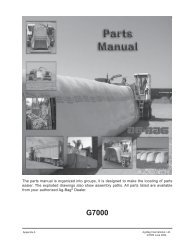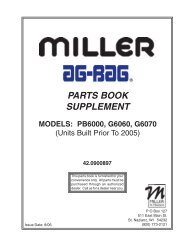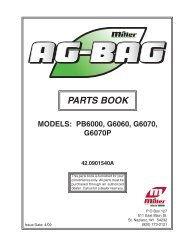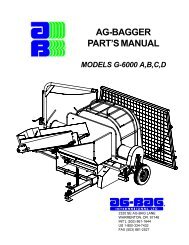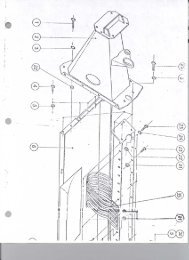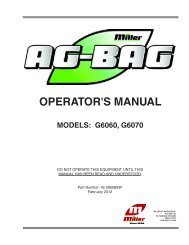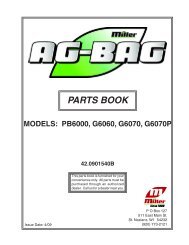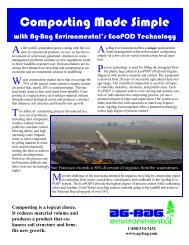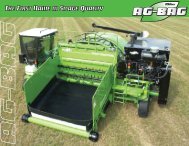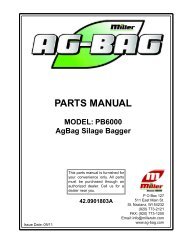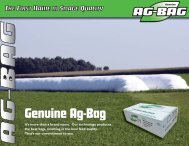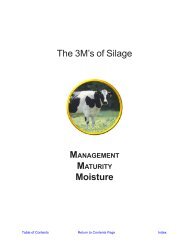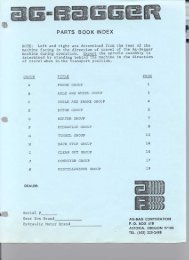Create successful ePaper yourself
Turn your PDF publications into a flip-book with our unique Google optimized e-Paper software.
Total annual<br />
storage costs<br />
for a bagging<br />
system can run<br />
14 to 18 percent<br />
less than<br />
bunkers,<br />
research shows.<br />
A high-quality plastic<br />
bag seals out sunlight<br />
and oxygen, maintaining<br />
fermentation<br />
and limiting dry matter<br />
losses.<br />
NUTRITECH ®<br />
<strong>Bag</strong>ged Systems Offer a Viable Alternative to Concrete<br />
A<br />
lthough the ever-present tower silo<br />
used to be the predominant means of<br />
ensiling on established dairies, many<br />
producers have reached a point that<br />
demands change. Old upright silos require overhaul.<br />
Climbing to change doors and service<br />
unloaders becomes more difficult. Excessive drymatter<br />
losses spur a drive for lower cost/higher<br />
quality silage. Many expanding dairies simply<br />
can’t build sufficient vertical storage, so bunkers<br />
are favored.<br />
But the drive for efficiency in feed storage<br />
has led many dairy producers to turn to a relatively<br />
new option. Storing chopped silage and wet<br />
hay in large plastic bags is a relatively recent<br />
practice compared to the more traditional methods.<br />
Using a machine that stores and compacts<br />
silage in specially made plastic bags, the system<br />
ferments feed in long, horizontal, oxygen-deficient<br />
tubes until needed for feeding. Why are producers<br />
finding bags to be a better option?<br />
Flexibility. Because virtually all of the system’s<br />
investment is in mobile machinery and bags, not<br />
concrete or blue steel, a bag-based system is highly<br />
flexible. The equipment is easily moved if needed,<br />
bags can be gradually phased into an operation—<br />
especially with the help of a custom bagger. And<br />
Typical Capital Investment To ensile 4,389 wet tons<br />
BUNKER<br />
• 8 above ground bunkers with shared walls<br />
• 20' x 320' apron; 42,400 sq. ft.excavation/fill<br />
@ 32¢ + 30,400 sq. ft. apron@ $1.80<br />
• Subtotal $121,428 + packing<br />
tractor $7,875 +loader $6,300 = Total $135,603<br />
because bags can be sealed easily, harvesting can<br />
be spread over a relatively long period if necessary,<br />
and feeding out leaves no exposed silage face to spoil.<br />
Each cutting or field of forage harvested under<br />
different conditions can be stored in its own bag,<br />
indexed by quality in order to easily change ingredients<br />
to maximize forage quality in the ration.<br />
Cost-effectiveness. When compared with new<br />
construction, a bag-based system shows a lower<br />
initial investment than concrete-based ones. And<br />
when compared to existing structures, if you look<br />
at all annual costs, including ownership costs and<br />
cost of spoilage, bags are the most cost-effective<br />
option, according to recent Wisconsin research.<br />
Lower storage losses. Because ensiling and<br />
sealing are more dependable than other horizontal<br />
storage, bagging produces a higher quality<br />
silage. Storage losses are comparable with tower<br />
silos and much lower than bunker silos.<br />
Safer. <strong>Bag</strong>ging silage reduces the conventional<br />
safety hazards of silage management. Their low<br />
height virtually eliminates the No. 1 cause of silorelated<br />
deaths: falling from elevation. And<br />
although bags aren’t immune from silage gas,<br />
according to New York research, even dangerous<br />
levels of gas are more likely to be vented quickly<br />
in the open air where bags are stored.<br />
BAGS<br />
• 32 - 8' x 150' bags stored 3' apart<br />
• 155' x 352' stone storage pad @ 50¢<br />
+ PTO powered bagger $17,400<br />
• Subtotal $44,680 + bagging<br />
tractor $3,375 + loader $6,300 = Total $54,355<br />
Assumes packing and bagging tractors devote 10 percent of total lifetime use to silage work; loader, 20 percent.<br />
Source: B Holmes, University of Wisconsin, 1996.<br />
Compare All Costs<br />
When you look at all ownership costs – interest and principal<br />
on capital; operational costs such as labor, maintenance,<br />
repairs, fuel, plastic, and property tax; plus the value of<br />
spoilage – bags beat other storage in cost effectiveness,<br />
University of Wisconsin research shows.<br />
Herd Size1 55 cows 110 cows 219 cows<br />
Wet Quantity 2 1,097 tons 2,194 tons 4,389 tons<br />
Dry Quantity 384 ton DM 768 ton DM 1,536 ton DM<br />
Initial Capital Investment<br />
Concrete Stave $73,825 $105,985 $202,345<br />
Concrete Bunker $58,525 $78,945 $135,603<br />
<strong>Bag</strong>ged Silage $33,895 $40,715 $54,355<br />
Annual Storage Costs ($/Year)<br />
Concrete Stave $17,502 $27,755 $53,702<br />
Concrete Bunker $17,290 $28,219 $53,027<br />
<strong>Bag</strong>ged Silage $14,703 $24,322 $43,562<br />
1. Estimates based on 7.0 ton DM forage/adult cow with replacement/year.<br />
2. Estimates assume 65% moisture content. (Source: Holmes, 1995, modified)



